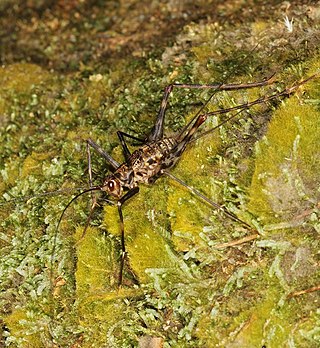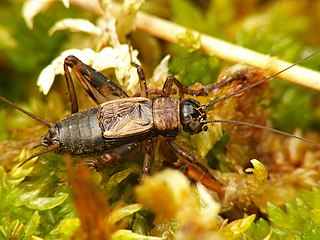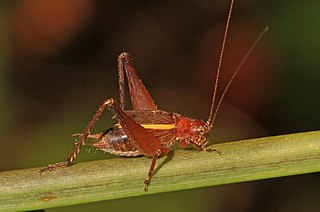
Gryllinae, or field crickets, are a subfamily of insects in the order Orthoptera and the family Gryllidae.

Tree crickets are insects of the order Orthoptera. These crickets are in the subfamily Oecanthinae of the family Gryllidae.

Gryllacrididae are a family of non-jumping insects in the suborder Ensifera occurring worldwide, known commonly as leaf-rolling crickets or raspy crickets. The family historically has been broadly defined to include what are presently several other families, such as Stenopelmatidae and Rhaphidophoridae, now considered separate. As presently defined, the family contains two subfamilies: Gryllacridinae and Hyperbaeninae. They are commonly wingless and nocturnal. In the daytime, most species rest in shelters made from folded leaves sewn with silk. Some species use silk to burrow in sand, earth or wood. Raspy crickets evolved the ability to produce silk independently from other insects, but their silk has many convergent features to silkworm silk, being made of long, repetitive proteins with an extended beta-sheet structure.

Trigonidiinae is a subfamily of insects in the order Orthoptera, suborder Ensifera, based on the type genus Trigonidium. They are often referred to as sword-tail crickets, winged bush crickets or trigs.

Phalangopsinae, occasionally known as spider crickets, are a subfamily of crickets in the family Phalangopsidae. Members of Phalangopsinae are found worldwide in tropical and subtropical regions. Most species in the subfamily are nocturnal and can be found in rocky areas, near fallen wood, and the understory of forests. Some species are gregarious, gathering in large numbers.

The Eneopterinae are a subfamily of crickets, in the family Gryllidae, based on the type genus Eneoptera. It is one of several groups widely described as "true crickets". Of the more than 500 species that make up this subfamily, most occur in moist, tropical habitats. These insects are medium to large and brown or gray in color. They eat plant leaves, flowers, and fruits and can occasionally cause economic damage. Their eggs are deposited in pith, bark, or wood. Eneopterinae show a great diversity in stridulatory apparatus, signals emitted, and associated behaviour.

Nemobiinae is a subfamily of the newly constituted Trigonidiidae, one of the cricket families. The type genus is Nemobius, which includes the wood cricket, but members of this subfamily may also be known as ground crickets or "pygmy field crickets".
Hygronemobius is a genus of insect in family Gryllidae.

Gymnogryllus is a genus of crickets in family Gryllidae and tribe Gryllini. Species are recorded from Africa, Asia and Australia.

Homoeogryllus is a genus of cricket in the subfamily Cachoplistinae and tribe Homoeogryllini. The recorded distribution is: Africa and Peninsular Malaysia.

Hapithinae is a subfamily of insects in the cricket family Gryllidae. It is one of several groups referred to in American English as "bush crickets", although this term can be confused with the Tettigoniidae.

Podoscirtinae is a subfamily of crickets in the family Gryllidae.

The Phalangopsidae are a recently reconstituted family of crickets, based on the type genus PhalangopsisServille, 1831 from South America. Priority for family-group names based on this genus dates from Blanchard's "Phalangopsites".
Trellius is an Asian genus of crickets in the family Phalangopsidae, subfamily Phaloriinae, tribe Phaloriini.
Vescelia is a genus of crickets in the family Phalangopsidae, subfamily Phaloriinae, tribe Phaloriini. Species have been found in: Japan, China, Vietnam, Borneo and the Philippines.
The Sclerogryllinae are a subfamily of crickets, in the family Gryllidae, based on the type genus Sclerogryllus. They may be known as "stiff-winged crickets" are terrestrial insects, distributed in: tropical Asia, Korea, Japan and West Africa.
Aphonomorphini is a tribe of crickets in the subfamily Hapithinae. There are about 6 genera and more than 90 described species in Aphonomorphini.

Gryllini is a tribe of crickets and typical of the family Gryllidae. Species are terrestrial, carnivorous or omnivorous and can be found in all continenents except Antarctica.
Zvenella is a genus of crickets in the tribe Podoscirtini. Species have been recorded in: southern China, Indochina and Sumatra.
Luzarinaeis a subfamily of crickets in the family Phalangopsidae.











